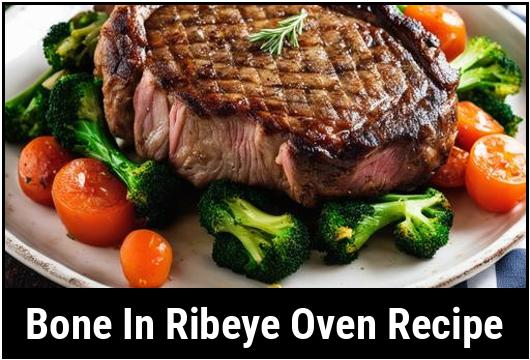
The Perfect Bone-In Ribeye: From Selection To Cooking
Welcome to the ultimate guide on cooking a mouthwatering bone-in ribeye in the oven. Whether you’re a seasoned home cook or a beginner in the kitchen, this comprehensive article will take you through the entire process, from selecting the perfect cut to achieving the ideal doneness. Get ready to dive into the world of food science, culinary details, and expert tips that will elevate your cooking skills to new heights. So, grab a pen and paper to take notes and let’s get started!
Understanding the Food Science of a Bone-In Ribeye
Before we delve into the culinary details, let’s take a moment to appreciate the science behind a bone-in ribeye. This classic cut is known for its rich marbling, which means it contains a good amount of intramuscular fat. This marbling plays a crucial role in delivering exceptional flavor, tenderness, and juiciness to the meat.
When cooking a ribeye, the heat causes the fat to melt and distribute throughout the meat, resulting in intense flavor and an incredibly moist texture. This also helps to prevent the steak from drying out during the cooking process, making it ideal for oven cooking.
Selecting the Perfect Bone-In Ribeye
Choosing the right ribeye is the first step towards creating an exceptional dish. Here are some key points to consider when selecting your meat:
-
Grade: Opt for a ribeye graded USDA Prime or Choice. These grades guarantee superior tenderness, juiciness, and well-marbled meat. However, if Prime or Choice is not available, you can still achieve fantastic results with a good-quality ribeye from your local butcher or supermarket.
-
Appearance: Look for rich marbling throughout the meat. The white flecks of fat intertwined with the muscle fibers should be evenly distributed. Additionally, ensure the steak has a bright red color and avoid any steaks with a grayish tint.
-
Thickness: Aim for a ribeye that is at least 1.5 to 2 inches thick. This thickness allows for a perfect balance between a flavorful crust and a juicy interior when cooking in the oven.
-
Bone-In: Choosing a bone-in ribeye adds extra flavor and ensures even cooking. The bone acts as a natural insulator that helps to distribute heat more evenly throughout the meat.
Cleaning and Preparing the Ribeye
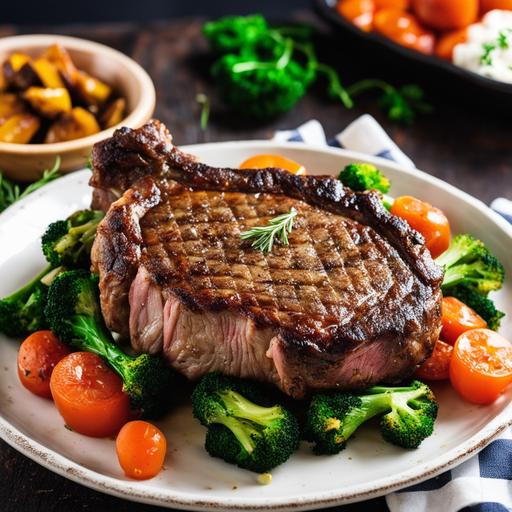
Once you’ve selected your mouthwatering bone-in ribeye, it’s time to prepare it for cooking. Follow these steps to ensure your steak is ready to hit the oven:
-
Unpack: Remove the ribeye from its packaging and let it rest at room temperature for about 30 minutes. Allowing the meat to come to room temperature ensures even cooking throughout.
-
Pat Dry: Use paper towels to gently pat the steak dry. This removes any excess moisture from the surface, allowing for better browning and crust development during cooking.
-
Seasoning: Liberally season both sides of the ribeye with kosher salt and freshly ground black pepper. This simple seasoning enhances the natural flavors of the meat. You can also add any desired additional seasonings like garlic powder, smoked paprika, or rosemary for extra depth and aroma.
Pro Tips for Cooking a Perfect Bone-In Ribeye
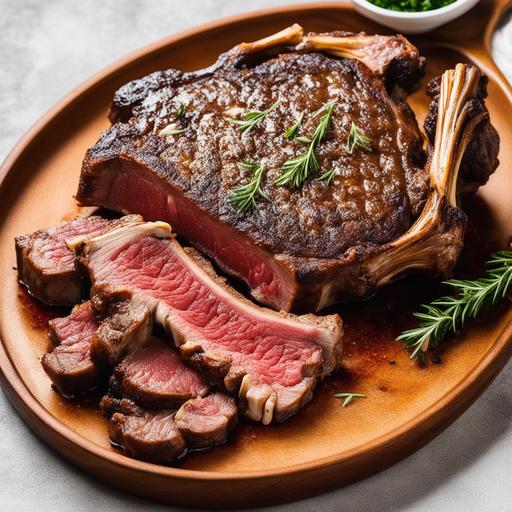
Now that your ribeye is ready, it’s time to dive into the nitty-gritty details of cooking it to perfection. Keep the following tips in mind to elevate your oven-cooked ribeye game:
-
Preheating the Oven: Before placing the ribeye in the oven, preheat it to a high temperature, such as 450°F (230°C). This initial burst of intense heat helps to form a beautiful sear on the steak’s surface and locks in the juices.
-
Using an Oven-Safe Skillet: Instead of relying solely on the oven, start by searing the ribeye in an oven-safe skillet on the stovetop. This technique, known as the reverse sear, ensures a delightful crust while gently cooking the interior.
-
Searing the Steak: Heat a small amount of oil or clarified butter in the skillet over high heat. Carefully place the ribeye in the skillet and sear it for about 2-3 minutes on each side until a deep brown crust forms. This step adds depth of flavor and enhances the visual appeal of your steak.
-
Using an Oven Thermometer: To ensure precise cooking, invest in an oven-safe meat thermometer. Insert the thermometer probe into the thickest part of the ribeye before placing it in the oven. This will help you monitor the internal temperature and achieve your desired level of doneness.
-
Resting the Ribeye: Once the ribeye reaches your desired internal temperature, remove it from the oven and let it rest on a cutting board for at least 5 minutes. This essential step allows the juices to redistribute throughout the meat, resulting in a more succulent and tender steak.
Checking for Doneness and Variations in Cooking
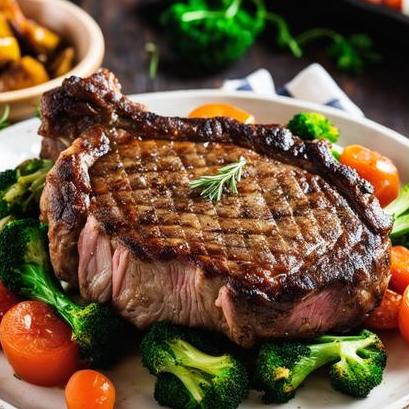
Achieving the perfect level of doneness is a personal preference, and knowing how to check for it is a fundamental skill. Here are the general guidelines for checking the doneness of your bone-in ribeye:
-
Rare: An internal temperature of 125°F (52°C) with a bright red center. The steak is softly tender and boasts a lot of juiciness.
-
Medium Rare: An internal temperature of 135°F (57°C) with a warm red center. The steak is still tender, juicy, and bursting with flavor.
-
Medium: An internal temperature of 145°F (63°C) with a warm pink center. The meat is firmer, slightly less juicy, but still quite flavorful.
-
Medium Well: An internal temperature of 155°F (68°C) with a slightly pink center. The steak is firmer, less juicy, and the flavors are more subdued.
-
Well-Done: An internal temperature of 160°F (71°C) with no pinkness. The meat is drier and less juicy, but some find enjoyment in its fully cooked texture.
Remember that everyone’s preference may differ, so use these guidelines as a starting point and adjust accordingly.
Recipe: Oven-Roasted Bone-In Ribeye
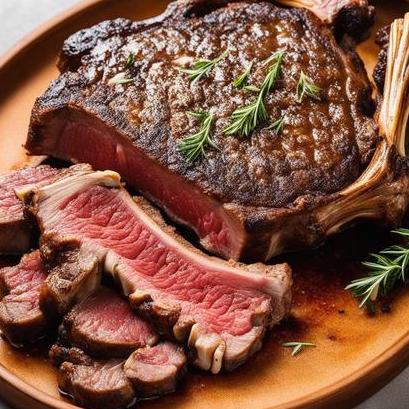
Now that you’ve grasped the science, selection, preparation, and cooking tips, let’s put everything together in a delectable recipe that will make your taste buds dance. Here is a step-by-step recipe for oven-roasted bone-in ribeye:
Ingredients:
-
1 bone-in ribeye steak (1.5 to 2 inches thick)
-
Kosher salt
-
Freshly ground black pepper
Instructions:
-
Preheat your oven to 450°F (230°C) and make sure the steak is at room temperature.
-
Pat the ribeye dry with paper towels to remove any excess moisture.
-
Season both sides of the ribeye generously with kosher salt and freshly ground black pepper.
-
Heat an oven-safe skillet over high heat and add a small amount of oil or clarified butter.
-
Carefully place the seasoned ribeye in the hot skillet and sear for 2-3 minutes on each side until a deep brown crust forms.
-
Once seared, insert an oven-safe meat thermometer into the thickest part of the ribeye.
-
Transfer the skillet with the ribeye to the preheated oven and roast until the steak reaches your desired level of doneness. Refer to the doneness guidelines mentioned earlier for internal temperature targets.
-
Once cooked, remove the ribeye from the oven and let it rest for at least 5 minutes on a cutting board.
-
Slice the bone-in ribeye against the grain, if desired, and serve it hot with your favorite accompaniments.
Avoiding Overcooked or Undercooked Ribeye
It’s important to note that while cooking a bone-in ribeye, there’s a fine line between achieving the perfect doneness and overcooking or undercooking. Here are a few critical tips to avoid these mishaps:
-
Use an oven-safe meat thermometer: This will help you closely monitor the internal temperature and avoid overcooking. Remember, the internal temperature will continue to rise slightly as the steak rests.
-
Start with a high-temperature sear: The initial sear locks in juices, enhances flavor, and provides a head start in achieving the desired doneness.
-
Don’t rush the resting process: Allowing the ribeye to rest after cooking is crucial for evenly distributing the juices. This step ensures optimal tenderness and prevents the steak from drying out.
-
Practice makes perfect: Cooking a bone-in ribeye is an art that improves with experience. Don’t be discouraged if your first attempt doesn’t meet your expectations. Embrace the learning process and enjoy the journey of creating amazing dishes in your kitchen.
Test Your Culinary Skills with Variations
Now that you’ve mastered the basic technique, it’s time to explore some exciting variations to elevate your bone-in ribeye experience. Here are a few delicious ideas:
-
Garlic and Herb Butter: Prepare a garlic and herb compound butter by mixing softened butter with minced garlic, finely chopped fresh herbs (such as rosemary and thyme), salt, and pepper. Once the ribeye is seared, spread a spoonful of the compound butter on top and let it melt in the oven. This adds a burst of flavor and richness.
-
Red Wine Reduction: Create a luxurious red wine reduction by deglazing the skillet used for searing the ribeye with red wine, beef stock, minced shallots, and a touch of butter. Simmer until the sauce thickens, then drizzle it over the cooked ribeye for a decadent touch.
-
Coffee and Spice Rub: Combine dark coffee grounds, smoked paprika, brown sugar, cayenne pepper, and salt to form a dry rub. Generously coat the ribeye with this mixture before searing for a unique and savory flavor profile.
These variations are just the tip of the iceberg. Feel free to experiment with different marinades, glazes, and spice blends to create your own signature bone-in ribeye masterpiece.
Celebrating the Perfect Bone-In Ribeye
Congratulations! You’ve completed this comprehensive journey through the world of bone-in ribeye oven cooking. By now, you should feel confident in selecting, preparing, and cooking a mouthwatering ribeye that will surely impress your loved ones and elevate your culinary expertise.
Remember, cooking is an art form, and mastering it takes time. Embrace the journey, enjoy the process, and savor every delicious bite of your perfectly cooked bone-in ribeye. With practice and passion, you’ll become an expert in the kitchen, ready to tackle any culinary challenge that comes your way. Happy cooking!
FAQS On Bone In Ribeye Oven Recipe
Can I Cook A Bone In Ribeye In The Oven?
Yes, you can cook a bone in ribeye in the oven. It is a great option for those who do not have access to a grill or prefer to cook indoors.
What Temperature Should I Set My Oven To For A Bone In Ribeye?
It is recommended to set your oven to 425°F for medium-rare and 450°F for medium. This will ensure a perfectly cooked and juicy ribeye.
How Long Should I Cook A Bone In Ribeye In The Oven?
The cooking time for a bone in ribeye can vary depending on the size and desired level of doneness. As a general guideline, a 1-inch thick steak will take about 12-14 minutes for medium-rare and 16-18 minutes for medium.
Do I Need To Marinate A Bone In Ribeye Before Cooking It In The Oven?
While marination is a personal preference, it is not necessary for cooking a bone in ribeye in the oven. The natural flavor and tenderness of the meat is enough to provide a delicious and satisfying meal.
How Do I Know When My Bone In Ribeye Is Cooked To My Desired Level Of Doneness?
The best way to determine the level of doneness for your ribeye is by using an instant-read meat thermometer. For medium-rare, the internal temperature should be around 135°F and for medium, it should be around 145°F. If you do not have a thermometer, you can also use the finger test method to check the doneness of the meat.


